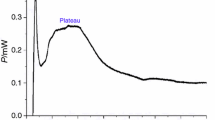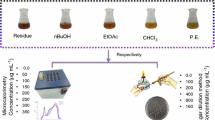Abstract
Properties theory of traditional Chinese medicine has been used thousands of years. Borneol, an important drug, was widely used for acute illness—“Rebi” in Chinese. However, in Chinese Pharmacopoeia (Ch.P), borneol is recorded as three kinds: l-borneol (B1), d-borneol (B2) and synthetic borneol (B3). In the study, the power–time (P–t) curves generated by P. aeruginosa which were disturbed by borneol were investigated through microcalorimetry; afterward, some thermo-kinetic parameters were obtained from the curves to characterize the metabolism of P. aeruginosa. The parameters were analyzed by principal component analysis. The results showed that borneol expressed different drugs properties. The half-maximal influences concentration (IC50) value of B1 was lower than those of B2 and B3. Especially, the IC50 of B1 was 447.185 μg mL−1. The influences of three kinds of borneol were l-borneol (B1) > synthetic borneol (B3) > d-borneol (B2), which met the long-term cognition. This could provide guidance for clinical use of borneol with different drugs properties.





Similar content being viewed by others
Abbreviations
- TCM:
-
Traditional Chinese medicine
- Ch.P:
-
Chinese Pharmacopoeia
- B1 :
-
l-borneol
- B2 :
-
d-borneol
- B3 :
-
Synthetic borneol
- PCA:
-
Principal component analysis
- I :
-
Influence rate
- IC50:
-
Half-maximal inhibitory concentration
- CHM:
-
Chinese herbal medicine
- CGMCC:
-
China General Microbiological Culture Collection Center
- LB:
-
Luria–Bertani
- TAM:
-
Thermal activity monitor
- CFU:
-
Colony-forming units
- PCs:
-
Principal components
- PLS-DA:
-
Partial least squares discriminant analysis
References
National Pharmacopoeia Commission. Pharmacopoeia of People’s Republic of China. 2015.
Wang J, Zeng N, Xia HL, Huang LH. A new model of properties theory study. J Tradit Chin Med. 2013;54(2):99–102.
Dai CM, Xiao XH, Peng C, Sun YQ. Speculating about scientific investigation on properties theory. Chin Tradit Pat Med. 2010;32(3):480–2.
Wadso I. Characterization of microbial activity in soil by use of isothermal microcalorimetry. J Therm Anal Calorim. 2009;95:843–50.
Tan AM, Xu B, Huang SQ, Qu SS. Thermochemical study on the growth metabolism of human promyelocytic leukemia HL-60cells inhibited by water-soluble metalloporphyrins. Thermochim Acta. 1999;333:99–102.
Kong WJ, Li ZL, Xiao XH, Zhao YL, Zhang P. Activity of berberine on Shigella dysenteriae investigated by microcalorimetry and multivariate analysis. J Therm Anal Calorim. 2010;102:33–6.
Zhao Y, Yan D, Wang J, Zhang P, Xiao X. Anti-fungal effect of berberine on Candida albicans by microcalorimetry with correspondence analysis. J Therm Anal Calorim. 2010;102:49–55.
Kong WJ, Jin C, Xiao XH, Zhao YL, Li ZL, Zhang P, Liu W, Li XF. Comparative study of effects of two bile acid derivatives on Staphylococcus aureus by multiple analytical methods. J Hazard Mater. 2010;179:742–7.
Wang J, Cheng DH, Zeng N, Xia HL, Fu Y, Yan D, Zhao YL, Xiao XH. Application of microcalorimetry and principal component analysis. J Therm Anal Calorim. 2010;102:137–42.
Chen C, Qu F, Wang J, Xia XH, Wang JB, Chen Z, Ma X, Wei SZ, Zhang YM, Li JY, Gong M, Wang RL, Liu HH, Yang ZR, Li YG, Zhao YL, Xiao XH. Antibacterial effect of different extracts from Wikstroemia indica on Escherichia coli based on microcalorimetry coupled with agar dilution method. J Therm Anal Calorim. 2015;. doi:10.1007/s10973-015-4999-9.
Wu MQ, Qu F, Zhao YL, Wang JB, Su HB, Chen C, Zhang CL, Guo YL, Zhang P, Ma X, Yang ZR, Zhang YM, Xiao XH. Microcalorimetry and turbidimetry to investigate the anti-bacterial activities of five fractions from the leaves of Dracontomelon dao on P. aeruginosa. J Therm Anal Calorim. 2015;. doi:10.1007/s10973-015-4932-2.
Bellavia G, Cordone L, Cupane A. Calorimetric study of myoglobin embedded in trehalose-water matrixes. J Therm Anal Calorim. 2009;95:699–702.
Montanari ML, Andricopulo AD, Montanari CA. Calorimetry and structure activity relationships for a series of antimicrobial hydrazides. Thermochim Acta. 2004;417:283–94.
Ingemar W. Isothermal microcalorimetry in applied biology. Thermochim Acta. 2002;394:305–11.
Xie CL, Tang HK, Qu SS, Liao Yt, Liu HS. Microcalorimetric study of bacterial growth. Thermochim Acta. 1988;123:33–41.
Cova TF, Pereira JL, Pais AA. Is standard multivariate analysis sufficient in clinical and epidemiological studies. J Biomed Inform. 2013;46:75–86.
Adam B, Tomasz B, Tomasz W, Marek S. Clinical data analysis with the use of artificial neural networks (ANN) and principal component analysis (PCA) of patients with endometrial carcinoma. Rep Pract Oncol Radiother. 2005;10(5):239–48.
Zhao Y, Wang J, Sun X, Jia L, Li J, Shan L, Li R, Liu H, Wang R, Song X, Li Y, Xiao X. Microcalorimetry coupled with chemometric techniques for toxicity evaluation of Radix Aconiti Lateralis Preparata (Fuzi) and its processed products on Escherichia coli. Appl Microbiol Biotechnol. 2014;98(1):437–44.
Zhou SH, Xiao XH, Zhao YL, Dai CM, Zhu JC, Liu Y. Biothermokinetic studies on four properties of traditional Chinese medicine: comparison of properties of Zuojinwan and Fanzuojin by microcalorimetry. China J Chin Materia Med. 2004;29(12):1183–6.
Sun ZY, Zhao YL, Wang JB, Li RS, Wei SS, Jiang FJ, Xiao XH. Study on hot property of Aconiti Lateralis Radix Praeparata and its compatibility with Zingiberis Rhizoma based on animal temperature tropism. Chin Herb Med. 2012;4(4):294–300.
Acknowledgements
The authors thank reviewers for their critical comments provided during revision and also wish to thank all authors of references. This work was financially supported by grants from National Natural Science Foundation of China (81473371, 81703725 and J1310034) and Sichuan Province Clinical Chinese Pharmacy Science and Technology Innovation Youth Team (2017TD0001).
Author information
Authors and Affiliations
Corresponding author
Ethics declarations
Conflicts of interest
The authors of this manuscript state that they do not have any conflict of interest and there is nothing to disclose.
Electronic supplementary material
Below is the link to the electronic supplementary material.
Rights and permissions
About this article
Cite this article
Ma, X., Xie, Q., Wu, M. et al. Microcalorimetric study of the effect of l-borneol, d-borneol and synthetic borneol on the growth of P. aeruginosa . J Therm Anal Calorim 131, 1681–1689 (2018). https://doi.org/10.1007/s10973-017-6627-3
Received:
Accepted:
Published:
Issue Date:
DOI: https://doi.org/10.1007/s10973-017-6627-3




